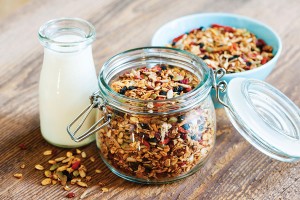Food for thought: How much does the average American family spend on groceries per month?
The national average is around $250 a week for a family of four. How much we spend on groceries varies of course, based on many factors like income, region & members per household – as well as whether we eat out – but groceries are still one of the biggest expenses families have, after the rent or mortgage bill.
The question is, how to eat for less but still eat healthy? How do you get the best quality for the best deal (not necessarily the cheapest) on a minimum budget? Here are ways to save money and still make sure you’re feeding your family a healthy and well-balanced diet.


Have a meal plan. Make a meal plan a week in advance and go shopping armed with a list. Shopping with a plan helps curb impulse spending. When we don’t have a meal plan we tend to make more trips to the store, and the more trips we make, the more we spend. Do keep an eye out for useful sale items that will benefit your budget in the long run – make those items part of your upcoming meal planning.
Shop the sales. Read your favorite stores’ weekly ads. When your favorite items are on sale, buy enough to make several meals. For example, if chicken is on sale, buy and cook enough to make chicken and dumplings, chicken tacos, and a chicken & broccoli casserole.
Know your area’s stores. Different stores offer different standard “best price” items. Grocery Outlet may be the best place to buy organic salad mix while Trader Joe’s may offer the best pricing on organic peanut butter; WinCo stocks milk alternatives like soy or almond milk at good prices while your local natural food store likely offers discounts on bulk bags of organic juicing carrots and items preordered by the case. Seek out farmers to buy directly from the source, i.e. for items like honey.
Use coupons. Coupons may seems like a waste of time – how can a 25¢ coupon make a dent in your grocery bill? The big savings comes from using coupons strategically, by combining manufacturer’s coupons with store coupons and product sales. For example, if your local grocery store offers an item on sale at two for $5, and you have two 50¢ coupons from the manufacturer as well as two $1 coupons from the store, that amounts to a $3 savings in addition to the sale price.
Consider buying frozen fruits and vegetables. Fresh produce is ideal, but when you can’t buy fresh, frozen is second best. I love buying frozen fruit for smoothies and sorbet. You can find frozen fruit at some dollar stores – most likely it won’t be organic, but is a huge savings compared to a regular grocery store prices.
Use vegetables to replace meats. This cuts costs and adds notable health benefits. One mom we spoke with buys lean ground beef, then prepares it with lots of carrots, onions and other veggies. Her kids love participating by using a pull mincer like the one mentioned in this month’s Localicious column to chop up the vegetables. She freezes some to use later in burritos and casseroles and says it’s a great way to sneak extra veggies into meals.
Avoid pre-packaged foods. Foods like instant oatmeal, packaged salad mixes and prepared snacks not only have a convenience fee added to the cost, they often contain excessive amounts of salt, sugar and other unhealthy additives. Buy whole foods in bulk – it’s more cost-effective to create your own mixes, then pre-package them yourself into single or family serving sizes. Invest in a Vitamix or Nutri Bullet type blender and make your own almond milk and nut butters (such as cashew butter) – it’s easy to do, and these are especially delicious when they are freshly made.
Have regular family “cooking days.” Get everyone on board to help prepare large quantities of ingredients like poultry, pesto, tomato sauce and soup stocks that can be frozen and later added into recipes.
Assess your grocery expenditures and modify to cut costs.
Look at what grocery items you spend the most money on – one mom we talked with realized she was spending a lot of money on boxed cereals. Making your own granola allows you to choose quality ingredients and to control the amount of sweetener used – try the recipe below.
Plant a garden. My kids love to learn how food goes from farm to table. It’s important for young kids to learn about what it takes for farmers to produce the food we eat. Kids can help with planting seeds and daily tasks like watering. My oldest son has been involved in our garden from the time he started walking and loves everything about it. We are looking forward to the warmer days of spring and getting this year’s garden started! Gardening doesn’t always equate to big savings, but the food quality and experience makes it worth it.
Buy direct from farmers. Skip the middleman and buy direct from the region’s farmers. My boys and I love going to farmers markets and buying fresh local produce – we especially love buying fresh tomatoes, fruit and raw honey. You can also subscribe to receive weekly CSA produce boxes at some farms. Supporting local growers means healthier foods for your family, and a healthier community too. Visit North State Parent’s “Healthy Food Resources” section at http://www.northstateparent.com/
familyresources for more information.
Homemade, Easy-To-Make Granola
By Pamela Newman


- 5 cups rolled oats
- 1 Tbsp. cinnamon
- 1 tsp. nutmeg
- 2 tsp. vanilla extract
- 1 cup raw sunflower seeds
- 1 cup almonds and/or cashews
- 1 cup pure maple syrup
- ½ cup oil
- 2 cups dried fruit, chopped
- 1 cup raisins
- Optional: 1 Tbsp. almond extract
Put nuts, spices and liquid ingredients into a blender or food processor; pulse to chop the nuts and blend spices. Add this mixture and the oats into a big bowl and mix well. Pour onto a large baking sheet and bake at 325° for 1 hour or until slightly golden brown; stir every few minutes to prevent over-browning. Let the mixture cool, then mix in the dried fruit and raisins. Store in a large glass jar.
Posted in: Health & Nutrition
Comment Policy: All viewpoints are welcome, but comments should remain relevant. Personal attacks, profanity, and aggressive behavior are not allowed. No spam, advertising, or promoting of products/services. Please, only use your real name and limit the amount of links submitted in your comment.
You Might Also Like...

Let it Go: Some Worries Aren’t Worth The Time
Worrying, it’s something all parents do. I am guilty of it, especially when I lie awake at 3:00 a.m. with the silence of the house ringing in my ears. I […]

Scoliosis – Screening And Treatment Options
The words “scoliosis” and “S curve” were unknown to my family until the summer I was 12, and I fell into a pool. A trip to the pediatrician’s for a […]

Mindful Eating: Helping Your Child Make Healthy Food Choices
Good eating habits begin at home. Choosing mindfully what you feed your family, making healthier choices when eating out, and partnering with your child’s school are several important ways you […]
Real Fruit Popsicles
The recipe for these delicious and dietitian-approved frozen treats was adapted from the blog “All Things Green” by Maria Baath. I took her advice to make them a little sweeter […]



